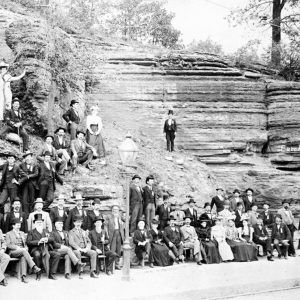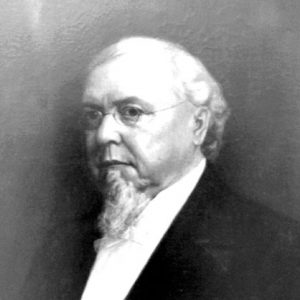calsfoundation@cals.org
Arkansas Medical Society
The Arkansas Medical Society (AMS), founded in 1875, describes itself as the premier professional organization for Arkansas physicians. The AMS supports physicians and seeks to improve the delivery of healthcare services.
In 1847, American allopathic physicians—that is, those within the regular medical mainstream—organized the American Medical Association (AMA) to promote medical educational and ethical standards. Established in the early 1840s, the Crawford County Medical Society was Arkansas’s earliest allopathic medical organization. Organized in 1870, the Arkansas State Medical Association (ASMA) was the first state organization for regular physicians. In 1873, a disagreement that divided the Little Rock and Pulaski County Medical Society members contributed to the ASMA’s eventual dissolution.
At a meeting held in Little Rock (Pulaski County) in 1875, a group of regular physicians organized anew as the Arkansas Medical Society. The AMS, whose members were required to be Arkansas residents and AMA-recognized medical school graduates, would “represent [physicians’] common interests” and enable them “to keep pace…in [medical] science and practice.” Dr. William B. Welch of Boonsboro (Washington County) served as the AMS’s first president. In 1879, the prospect of establishing Arkansas’s first medical school prompted the remaining ASMA members to join the AMS. The Journal of the Arkansas Medical Society began publishing in 1890.
Exclusion from AMS membership prompted African-American physicians to cofound the Arkansas Medical, Dental, and Pharmaceutical Association (AMDPA) in 1893. In the twenty-first century, the AMDPA is the state’s leading healthcare provider association for minorities. The AMS later allowed black physicians to become members. In 1925, AMS members’ wives organized the society’s Women’s Auxiliary. The AMS’s first female officer was Dr. Ruth E. Lesh, a Fayetteville (Washington County) gynecologist, who was elected the second vice president in 1938.
In the 1870s, the AMS supported the establishment of a state mental health facility. Beginning in 1885, Dr. Philo Oliver Hooper, an AMS member, served as board president and superintendent of the newly opened Arkansas State Lunatic Asylum (later the Arkansas State Hospital). The AMS was an early supporter of licensing for physicians, advocating successfully for Arkansas’s stronger medical licensing law of 1903, which replaced earlier weaker laws.
In the 1900s, the AMS joined the AMA in opposing contract practice—that is, corporations’ practices of hiring physicians for a fixed fee—viewing it as a form of exploitation. In 1906, the AMS stated its hope that Arkansas’s county medical societies would “pass resolutions opposing the acceptance of a position as contract doctor.”
In the 1920s, the AMS also followed the AMA’s lead in opposing compulsory health insurance and the Sheppard-Towner Maternity and Infancy Act (1921), policies that many physicians viewed as threats to the fee-for-service system. In 1921, the AMS’s Committee on Workmen’s Compensation and Social Insurance declared that “[health insurance] in this country would be calamitous, both to the public and to the profession.” In the 1920s, the AMS’s initial support for the state health department evaporated when the department utilized Sheppard-Towner funds to expand public health services.
From the 1930s until the 1950s, the AMS continued to oppose policies it perceived as threats to the fee-for-service system. At the AMS’s annual meeting in 1944, the society president claimed that “we have had a few tastes of ‘government in medical practice’ in [the New Deal’s] FERA, WPA, NYA, FSA…[which produced] much dissatisfaction among the patients [and] physicians.” In 1950, the AMS denounced President Harry S. Truman’s health insurance proposal as “socialized medicine” and lobbied for its defeat; the rise of the insurance industry, however, continued unabated as the century went on.
In the twenty-first century, the AMS continues to serve as Arkansas physicians’ source of professional advocacy and healthcare-related news. Established in 1985, the AMS’s bipartisan political action committee, known as ARKMED-PAC, supports political candidates it considers to be pro-medicine.
For additional information:
Arkansas Medical Society. http://www.arkmed.org (accessed November 10, 2014).
Baird, W. David. Medical Education in Arkansas, 1879–1978. Memphis: Memphis State University Press, 1979.
Burrow, James G. AMA: Voice of American Medicine. Baltimore: Johns Hopkins University Press, 1963.
“Contract Practice.” The Monthly Bulletin of the Arkansas Medical Society 2 (February 15, 1906): 6.
Fink, M. “The State Board.” Journal of the Arkansas Medical Society 5 (1908): 49–52.
Miller, Elissa Lane. “From Private Duty to Public Health: A History of Arkansas Nursing, 1895–1954.” PhD diss., Memphis State University, 1989.
“Proceedings of the Forty-Fifth Annual Meeting of the Arkansas Medical Society.” Journal of the Arkansas Medical Society 18 (July 1921): 17–56.
Singleton, E. Mitchell. “Hot Springs Physicians and the Formation of the Arkansas Medical Society.” The Record (2012): 65–68.
“State Medical Convention of Arkansas, 1875.” Transactions of the Arkansas Medical Society 1 (1875): 1–48.
Taggart, Sam. The Public’s Health: A Narrative History of Health and Disease in Arkansas. Little Rock: Arkansas Times Publications, 2013.
Welch, Melanie K. “Politics and Poverty: Women’s Reproductive Rights in Arkansas, 1942–1980.” PhD diss., Auburn University, 2009.
“Women’s Auxiliary to the Arkansas State Medical Society Report, 1925-1926.” Minutes and Reports, 1925–1940. Women’s Auxiliary to the Arkansas Medical Society Records, Box 285, File 8. Historical Research Center. University of Arkansas for Medical Sciences Library, Little Rock, Arkansas.
Melanie K. Welch
Mayflower, Arkansas
 Arkansas Medical Society Conventioneers
Arkansas Medical Society Conventioneers  Philo Hooper
Philo Hooper 



Comments
No comments on this entry yet.